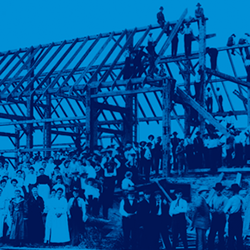There are countless ways to categorize collective human action (by legal entity, by sector, by formal/informal structure, by tax status, by geography, and on and on). But sociologist/political-scientist/historian Johan Galtung suggests there are essentially two types: thick-and-small (“the wheel” or “Beta”) and thin-and-big (“the pyramid” or “Alpha”).
In Galtung’s framing, “small/big” describes the size of the collective. The line between a small and big structure is “roughly the upper limit to the number of people a human being can identify, and relate to, positively and negatively.” According to anthropologist Robin Dunbar, that number is somewhere between 100 and 250 people, with 150 often used as a useful placeholder.
“Thick/thin” refers to the interactive relations within the structure. “Thick” interactive relations are particular, personal, specific, and therefore unique to each relationship. Think here about family, friends, villages, close associates in your social network. “Thin” interactive relations are more universal, functional, and even generic. Think here about professional relationships based on job title or function (or military rank or ownership status or other “type”), or think of big cities.
Obviously, “pyramid” structures can and do contain “wheel” structures within them (tight-knit working groups, for example). But you can’t get “big” without also favoring “thin” relationships as a dominant practice.
According to Galtung, much of the rise of modern society is due to the continuing development and dominance of “thin-and-big” structures: corporations, bureaucracies, institutional religion, and the like. He says that these “have provided us with material abundance and impressive control and coordination structures…. But deep sustenance and guidance they cannot offer.” Further, pyramid (Alpha) structures tend to crowd out and even dissolve wheel (Beta) structures, because, in part:
“Alpha requires full attention, because the jobs provided by Alpha are full time jobs, and because the occupants of Alpha positions are not supposed to think Beta thoughts.”
There’s lots to unbundle in this, including the larger “anomie and atomie” in our society that Galtung attributes to the pyramid, but my immediate point is more narrow: So many of our structural, managerial, and organizational assumptions in the nonprofit professional arts are drawn from “the pyramid” or the “thin-and-big” (stable job titles, hierarchies, departments, and so on), when so much of our work requires “the wheel” or the “thick-and-small” (collaborative, human-centric, highly specific to the individual members of the team).
Given, according to Galtung, that these two structures have been partnering and pressuring each other for all of human history, might we acknowledge they are in active tension/symbiosis in all that we do? And how does a “thin-and-big” organizing assumption make sense for an industry where the vast majority of organizations have less than 100 (and in fact less than 10) employees?
SOURCE: Johan Galtung. “Anomie/Atomie: On the Impact of Secularization/Modernization on Moral Cohesion and Social Tissue.” International Journal of Sociology and Social Policy 15, no. 8/9/10 (August 1, 1995): 121–47. https://doi.org/10.1108/eb013226.



The pyramids must be experienced. They were erected by societies “ignorant” of the values and goals of the Enlightenment, book publishing, and universal ability to read. So were the cathedrals. So was Stonehenge. Yet I am deeply touched and inspired by these sentinels left for us by the hard [“useless”?] projects of our distant ancestors.
Andrew: I always read – and enjoy – your blog. Thank you! While semantics may be mildly irritating (at least to me), I do know you think carefully about the words you use, which I have come to value. So: I prefer using the term “not-for-profit” to describe our sector’s business model, rather than “nonprofit.” It seems to me the former clarifies the intent of the designation: we do not primarily exist to generate profit, but yielding positive operating results is OK. To me, the latter almost implies a “goal,” or a pre-determined statement of desired outcome? Semantics!
Andrew, your final question brings to mind the tension I’ve always felt between formal job descriptions and organizational charts and this reality: When a member of a small to medium-sized staff is replaced, all the jobs are de facto redefined to cover the unique constellation of experience/capabilities that left and to take advantage of the newly-arrived bundle of competencies/enthusiasm. We pretend to be businesses, but in many ways, we’re families.